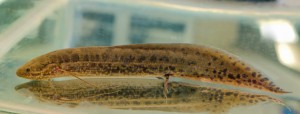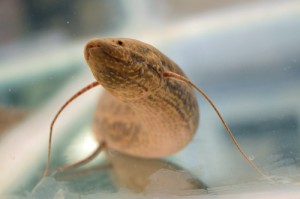
The African lungfish displays primitive walking behaviors in controlled conditions. (Photo: Yen-Chyi Liu/University of Chicago)
When you look at an African lungfish, you see an aquatic animal with an eel-like body and what appear to be small, scrawny limbs, which are actually pelvic fins.
A new study suggests this creature could up-end what we thought we knew about the evolution of life on Earth as it made its way from water to land.
After extensive video analysis, University of Chicago researchers found the African Lungfish uses its pelvic fins to lift itself off the surface and propel itself forward. Before now, scientists believed these abilities originated in the early species of tetrapods – creatures with four feet who appeared on Earth later than the lungfish’s ancestors.
The researchers think their observations will reshuffle our understanding of the order of evolutionary events that led up to creatures adapting to life on land. Fossil tracks thought to be the work of early tetrapods species could have instead been produced by lobe-finned ancestors of the lungfish.
The study’s lead author, graduate student Heather King, and her colleagues designed and built a special tank to study and videotape the lungfish from the side and below for in-depth analysis. They chose to videotape and observe the lungfish in action, because if they only looked at the bones, as one would with a fossil, it might not be apparent the animals could have the ability of locomotion.

Researchers found the African Lungfish uses its pelvic fins to lift itself off the surface and propel itself forward. (Photo: Yen-Chyi Liu/University of Chicago)
The researchers reported the lungfish demonstrated both “bounding” motions, where both limbs moved at the same time, and “walking,” with the fish alternating use of its limbs to move forward.
These behaviors, along with the ability to fully rotate its limb and to place each subsequent footfall in front of the joint, suggest to researchers that similar creatures, perhaps ancestors of the lungfish, would have been capable of producing some of the fossil tracks credited to tetrapods.
The group says its discovery suggests that many of the developments necessary for animals to make the transition from water to land may have taken place long before early tetrapods were able to take their first steps on land.
They believe the lobe-finned ancestors of the lungfish, as well as tetrapods, could be responsible for the evolution of hind-limb propulsion and the ability to walk at the bottom of a lake or marsh millions of years before the appearance of land-dwelling animals.





















It’s not a single stranded chain of evolution, more a tree or bush. Interesting though
Now really. Just what impact will this taxpayer funded study have on the well being of the human race?
How taste of this fish is, wondered we how can bring it to Friday night dinner!
Maybe it would go well in a gumbo.
Johnbh99, where does it say that this study was funded by taxpayers?
Just where do you think the money came from?? All of these outlandish studies are funded by the government. Who else would be dumb enough to pay a graduate student to video tape the belly of a fish in a tank.
Ok, so lets say yes, walking evolved underwater, then what? I’m a fan of science but we should focus our efforts on the future, not answering hypothetical questions about our past. I understand learning about our past helps us grow, but seriously, millions of years ago a fish may have started walking underwater, please tell us these studies are not tax payer funded.
Who else but some bureaucrat somewhere would approve such a waste of time. Ms King should be ashamed of herself.
Pure science has to be taxpayer funded precisely because it is of limited practical use. If we are going to understand the universe we live in and our place in it, we must study the past. That knowledge may not have market value or grow any food but it is priceless.
A good many of these “pure science” projects are proposed strictly for the grant and not for any other purpose. When it comes to taxpayer’s money, nothing but our liberty should be thought of as “priceless”.
Well, anti-science people, it’s difficult to explain the significance of basic scientific research to you, but I’ll try a simple example. Back in the 1960s, a fellow was intrigued by the way jellyfish glowed, so he spent a bunch of time and money studying it, undeterred by ridicule a lot like yours. Nowadays, every genetics lab in the word uses phosphorescent gene-tagging, and genetic research that requires tagging to know if gene replacement was successful has created many of the medicines and foods you encounter every day. Indeed, if you’re in the US, a significant amount of the food you eat is genetically modified–you probably eat food made possible by that “ridiculous” jellyfish research every day.
It’s hard at this point to say exactly what the significance of this lungfish study will be in the future, but it could indicate additional branchings in the evolutionary tree. The specific genes determining its shape and range of motions could turn up elsewhere–perhaps in human genetic mutations.The method of studying its motion could result in new technology for ocean-floor research, as study of insects has affected vehicular design.
Many, I suppose would like to end all research into history, as they believe they somehow already know everything there is to know about things that have already happened (though, of course, nearly everything they know about things that happened more than a few years ago actually comes from research).
One can argue about the relative cost of different types of research that adds to human knowledge, but I’m certain that it all is of much greater value than another cigarette boat or yacht for a rich person paying tax at rates that are at a historic low or another football or baseball stadium paid for by local taxes so that an already rich team owner can keep more money for him/herself. Lungfish research is also almost certainly of greater overall value to Americans than yet another military aircraft that’ll take fifteen years to design and build and then be grounded five years after it’s made–assuming it actually gets made.
If you want a better future, support the researchers, not the wealthy people who want don’t want to pay taxes at all, but want the middle class to pay for the US to occupy half the nations on earth.
Well, I capitulated to the fellow below and then I read your long rant. I am not anti-science and I am a very long way from being able (r even want) to buy a cigarette boat , but I do think we have enough class war rhetoric coming out of DC without any help from the scientific community. This country is in debt up to our eyeballs right now and it is not because we are under taxed. It is because we are spending too much. During such times it is necessary for everyone to cinch up the belt and help get things in order. When I ran a business and things got tough, we had to cut costs. We could not raise prices because the customer would not tolerate it. We cut production but did not cut jobs. We talked about it and everyone (1200 employees including me) took a 20% pay cut – some by taking a day off per week and others by just getting less money and working even more to get us out of the hole. I resent people like you who think your intellect entitles you to decide who should pay for what you do.
It isn’t a waste of time actually. Understanding the origins of motor pathways in less evolved organisms, such as walking, helps narrow down the parts of the brain and types of neurotransmitters involved in our walking as well (Evolution relates the past and present species fundamentally), and because it’s a simpler model it can be used as a realistic, less complex, starting point for development of therapies and cures of human movement pathologies.
Just because you don’t understand the point of someone’s experiment, doesn’t mean there isn’t one. I promise scientists are not motivated to perform countless hours of research and lab work if they don’t believe there is a purpose for their results.
Very well put, and point well taken.
But so you know, the reason why I questioned this research to begin with is because of the foolish ways our taxpaying dollars are being spent across the board, not just science. So your “anti-science people” label, not as well received as you explanation for the research.
I applaud, and feel lucky to have a scientific community that’s achieved as much as ours has and continues to contribute greatly to our country, nay, the world! Hows that, that stroke your lab coat wearing ego enough?
Listen, if you think for a second that we the people should sit idle as you continue on with research funded by us without questioning it, you’re in for a bumpy ride. Especially when your research is published and posted on a blog.
So, thank you anti Baseball, Football, US Military development, scientist, I appreciate your explanation, it was well received.
I agree, you win.
Ok, you win.
I fail to see the link in the theory of evolution. During my studies all i have been able to find proving the theory of evolution is that the government dropped the word “theory” when ever they started talking about the theory of evolution. People forget the fact that many Nobel prize winners that have founded studies with the human genome etc. believe that cells and dna are to complex to have just formed themselves from nothing. Somehow are founding fathers of modern science are forgotten because they’re ideas don’t go along with the national science foundations views.
Could this fish have evolved towards that of the salamander species; some type of lizard. Just looks similar to me…